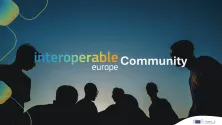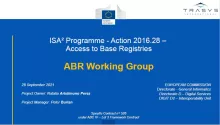Improving national and cross-border access to government data
Base registries represent authoritative databases and a trusted source of basic information on data items such as people, companies, vehicles, licences, buildings, locations and roads.
The ISA² Action 2016.28 ‘Access to Base Registries’ (ABR) aims at defining a common framework for base registries access and interconnection, and developing supporting tools that would make national and cross-border access to the base registries more efficient.
To achieve these goals:
1) all Member States should follow closely and respect the Once Only Principle standard and;
2) interfaces between national registers should be defined, published and harmonised at legal, organisational, semantic and technical levels.
However, the information needed for operating European public services is owned and managed by each EU Member State (or within an EU country). Therefore, this Action explores whether and how making the data contained in base registries open – following the appropriate security and privacy measures – could help foster interoperability / interconnection across European public services.
What are the benefits?
- More efficient and effective access to information across borders when establishing European public services.
- Faster and easier European public service establishment.
- Reduced administrative burdens.
- Development of base registries and interconnecting infrastructures rapidly and more cost-efficient.
What has been published so far?
The Base Registries Access and Interconnection Framework (BRAIF), which guides Member States on the creation of an ecosystem of interconnected base registries which exchange data and, therefore, facilitate the setup of integrated public services - available here;
Semantic specification BRegDCAT-AP that represents the data contained in base registries - Release, version 2.00, is available for download in all serialisation types in the ABR-BRegDCAT-AP;
Reusable Open Source tools, which in practice support the implementation of the BRegDCAT-AP: the Creator, Mapping Editor, Editor, Validator, and Harvester. The descriptions, use cases, source code, adaptability and deployment information are available in the ABR-BRegDCATAP-Tools;
The Guidelines for base registries interconnection, which provide recommendations and good practice examples collected from Member States and EU Institutions, and guide users on how to overcome the challenges Member States face, as well as how to simplify the work on BRs and RoR. The latest publication of the Guidelines, version 3.00, is available on the ABR Guidelines;
ABR Catalogue of Solutions, gathering information on more than 120 solutions from EU Member States and other countries that can be reused for suitable needs;
ABR Good Practices on building successful interconnections of base registries, providing examples from Member States initiatives to inspire interested audience;
ABR Factsheets, representing an analysis on the state-of-affairs in all EU countries, as well as the EFTA countries;
What is planned in 2021 Phase?
Feasibility study on creation and implementation of European Registry of Base Registries (ERBR), eLearning materials, and
continuous exchange of experiences and opinions among stakeholders from public administrations, academia, related EU projects, semantic experts, etc. during various activities, such as working groups, webinars, on Joinup, etc.

ABR - BRegDCAT-AP Tools
BRegDCAT-AP

The Interoperable Europe Community has been launched

Re3gistry presentation and video at the 2023 ENDORSE conference

ABR Webinar Highlights

The ABR course is now live!


